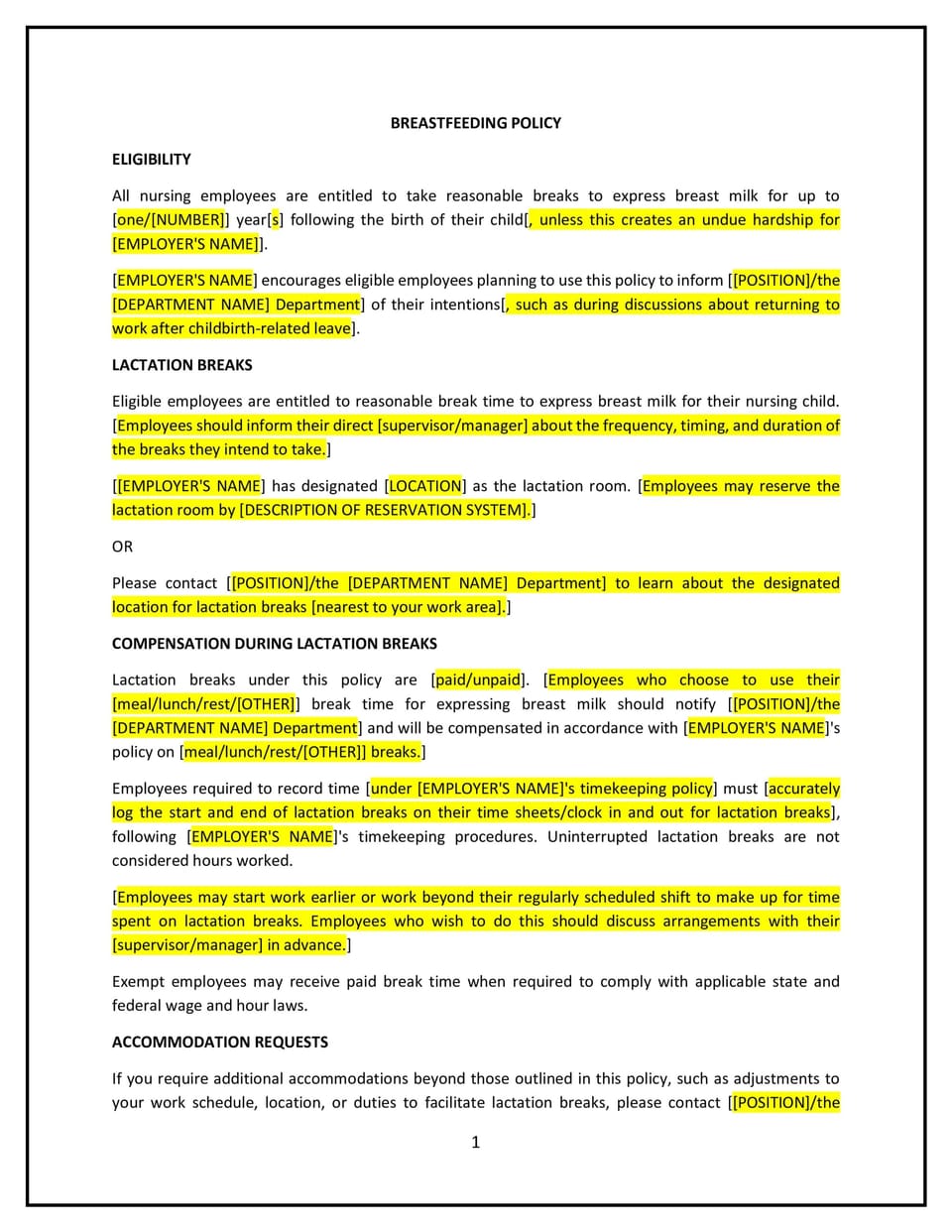Breastfeeding break policy (Alaska): Free template

Breastfeeding break policy (Alaska)
In Alaska, a breastfeeding break policy ensures that nursing employees have the necessary time and space to express milk during work hours. This policy supports compliance with federal and state laws, while fostering a supportive work environment. By implementing this policy, businesses demonstrate their commitment to accommodating the needs of working parents and promoting workplace equity.
Alaska's unique workforce conditions, including remote work and diverse industries, may require tailoring the policy to specific needs, such as providing flexibility for remote employees or accommodating varying work schedules. This approach helps ensure that all employees feel supported and valued.
How to use this breastfeeding break policy (Alaska)
- Define break allowances: Clearly outline the frequency and duration of breaks provided for expressing milk, ensuring they are reasonable and align with federal guidelines under the Fair Labor Standards Act (FLSA).
- Provide private spaces: Specify that a private, non-bathroom space will be made available for employees to express milk, ensuring it is clean, secure, and easily accessible.
- Address scheduling flexibility: Allow employees to schedule breastfeeding breaks as needed, depending on their individual requirements and work responsibilities.
- Communicate expectations: Ensure managers and employees understand the policy, including how to request accommodations and the importance of maintaining a respectful and supportive environment.
- Ensure compliance: Regularly review the policy to align with Alaska state laws and federal requirements, updating it as necessary to address changes in legislation or workplace practices.
Benefits of using a breastfeeding break policy (Alaska)
A breastfeeding break policy offers significant advantages for businesses in Alaska. Here’s how it helps:
- Supports compliance: Aligns with federal FLSA requirements and Alaska labor laws, helping businesses avoid penalties or legal disputes.
- Enhances employee retention: Demonstrates a commitment to supporting working parents, encouraging loyalty and reducing turnover.
- Promotes workplace equity: Creates a supportive environment that helps parents balance work and caregiving responsibilities, fostering inclusivity.
- Improves morale: Shows employees that the company values their well-being, contributing to higher job satisfaction and productivity.
- Encourages health benefits: Supports breastfeeding employees, which can lead to healthier outcomes for both mothers and their children, reducing absenteeism due to child-related illnesses.
Tips for using a breastfeeding break policy (Alaska)
- Be proactive: Communicate the policy to all employees during onboarding and ensure managers are trained to handle accommodation requests appropriately.
- Include remote employees: For businesses with remote or hybrid work models, provide guidance on how nursing employees can structure their breaks while working from home.
- Respect privacy: Emphasize the importance of confidentiality and privacy for employees using this policy, ensuring they feel comfortable expressing milk at work.
- Review facilities: Regularly assess lactation spaces to ensure they remain clean, comfortable, and functional for employees.
- Gather feedback: Periodically seek input from nursing employees to improve the policy and address any unmet needs.
Q: How many breaks should be provided under this policy?
A: Break frequency and duration should be based on the employee's needs, with breaks typically lasting 15-30 minutes every few hours, as outlined by FLSA guidelines.
Q: What type of space should be provided for breastfeeding breaks?
A: A private, non-bathroom space that is clean, secure, and free from interruptions should be made available to nursing employees.
Q: Does this policy apply to all businesses in Alaska?
A: Federal guidelines under the FLSA apply to most employers, but smaller businesses may qualify for exemptions. However, accommodating nursing employees is encouraged to promote equity and employee satisfaction.
Q: How can businesses support remote employees who are nursing?
A: Employers can allow remote employees to schedule breaks flexibly and provide any necessary resources or support to help them balance work and nursing responsibilities.
Q: What should I do if my business lacks space for a dedicated lactation room?
A: Consider converting a private office or conference room into a temporary lactation space, ensuring it meets privacy and cleanliness standards.
This article contains general legal information and does not contain legal advice. Cobrief is not a law firm or a substitute for an attorney or law firm. The law is complex and changes often. For legal advice, please ask a lawyer.


